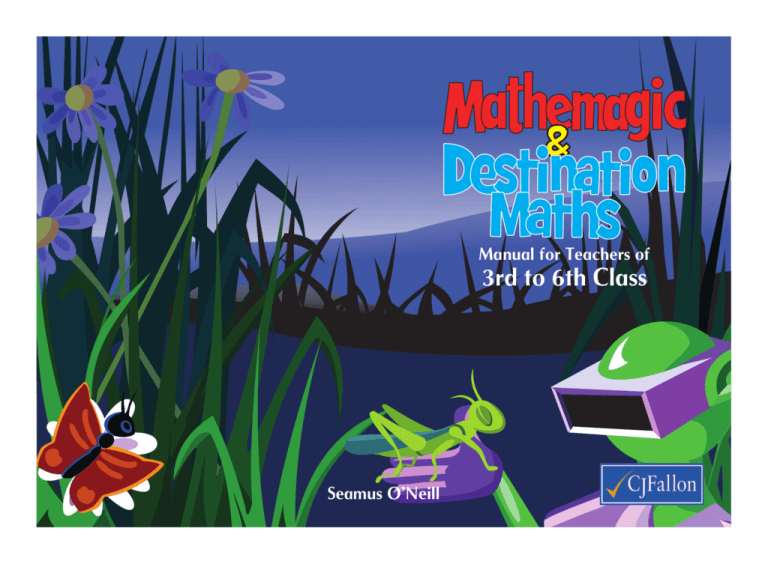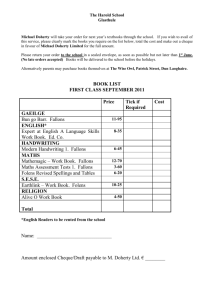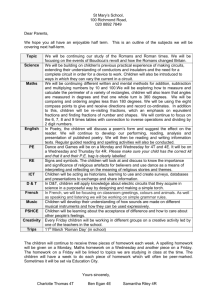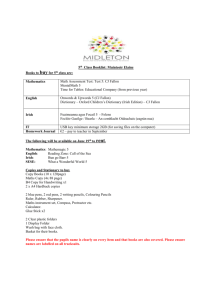
Manual for Teachers of
3rd to 6th Class
Seamus O’Neill
Manual for Teachers of
3rd to 6th Class
CONTENTS
Page
Quick Start Guide
2-3
How to navigate a tutorial
4
The Navigation Panel
5
How Mathemagic links-in
6
Third Class
7-8
DM Course 3: Modules A to F
9 - 14
Quick Reference Page: Third Class
15
Quick Reference Page: Fourth Class
16
Quick Reference Page: Fifth Class
17
Quick Reference Page: Sixth Class
18
Published by
CJ Fallon Ltd.
Ground Floor – Block B
Liffey Valley Office Campus
Dublin 22
© CJ Fallon Ltd.
2012
All rights reserved. No part of this publication may be
reproduced or transmitted, in any form or by any means,
electronic, mechanical, photocopying or otherwise,
without the prior written permission of the publishers.
&
Destination Maths
Manual for Teachers
3rd to 6th Class
offers pupils an enjoyable means of developing
and consolidating crucial mathematical concepts and skills.
The ‘Quick Start Guide’ will help you to get started with
and shows how it can be used in conjunction
with our
series.
to support the
We have revised the bulk of
objectives of the revised Irish Primary Maths curriculum but it is
worth noting that there are some aspects that are not directly
applicable. These have been included because they may offer
opportunities for extension and enrichment and may also provide
support in managing differentiation in the classroom.
supports all levels of mathematical ability in a clear,
attractive and challenging manner.
we
To acquaint yourself with the layout of
suggest you start with the five step tour. Once you become familiar
with its layout, you will be better able to locate the
tutorials that correspond with the lessons in
.
Quick
Start
Guide . .
Hi! My name is Dijit.
Sometimes they
just call me Dij.
This manual is targeted primarily at
for teachers at 3rd to 6th Class. The previously published manual
which covers
and
is intended
for teachers from Infants to 2nd Class. Teachers of 3rd Class should
consult both manuals as there is much content in Course 2 that
supports the 3rd Class curriculum. On pages 7 and 8 of this manual
we will outline the sections of
which link in with
.
Quick Start Guide to Destination Maths . . . . .
1
2
We start with a 5-step tour
of Destination Maths.
3
www.destinationmaths.ie
Step 1. Login
1
Main menu
This is the main menu of Course 3.
Course 3 has six tabs across the top.
Each tab opens a Module.
2
3
4
5
6
Teacher’s Home Page
and Explore Content page
This is the Teacher’s Home Page.
This is the Explore Content page.
HOME
EXPLORE CONTENT
This exit icon brings you back to the Explore Content page.
Click the Explore Content link.
2
Step 2. Launch the Course
Click Destination Maths Course 3.
Step 3. Choose a Module
Click the first tab: Numbers and Number Sense.
. . and how to link it with Mathemagic
4
Module menu
This module has 2 Units.
Unit 1. Large and Small Numbers
Unit 2. Numbers as Factors
5
Unit menu (the Tutorials)
This unit has 3 Tutorials.
Tutorial 1. Whole Numbers to One Million
Tutorial 2. Ordering and Rounding Whole Numbers
Tutorial 3. Negative Whole Numbers
Tutorial
The Quick Start Guide
continues on next page
with navigation
essentials.
Module 1: Number
Unit 1: Numbers from 1 to 5
This door exit icon brings you back to the Explore Content page.
Step 4. Choose a Unit
Click the Unit: Large and Small Numbers.
Step 5. Choose a Tutorial
Click the T-button
Whole Numbers
to choose the Tutorial:
to One Million.
Tutorial 1 links with Place Value
and Big Numbers beginning on
page 7 of Mathemagic 3,
Mathemagic 4, Mathemagic 5
and Mathemagic 6. The teacher
will know how far into the
tutorial to take the children
at any class level.
3
How to navigate a tutorial
in Destination Maths Courses 3 and 4
The initial screen sets out the ‘Learning Objectives’ and ‘Key Words’ which will be
covered in the tutorial. The bullet points give a useful overview of the tutorial
which is divided into
or lessons. Screens can be easily accessed through
the
which is pictured and explained below.
After login . . .
Choose
Click the ‘continue’ button at the bottom
right of the screen to start and work
through a tutorial.
Choose the
Numbers and
Number Sense
Choose the
Large and Small
Numbers
Choose the
Whole Numbers
to One Million
The navigation panel makes it easy to locate a specific screen in the tutorial.
A
1
2
slider
Learning
Objectives
4
When you click this button
you find a glossary of
the Maths terms used
in the Course as well
as a calculator.
To bring up the navigation
panel click the button with
the double arrow on the
right of the screen.
Drag the slider and click the
button to jump to a particular part of the tutorial.
Alternatively, you can mouse-click or use the arrows at each end of the navigation
panel to move the slider. Click the
button to hide the navigation panel.
workout 1
workout 2
workout 3
summary
3
S 1 2 3
. . . and use the Navigation Panel
to link-in Mathemagic
“ . . We know that
0, 1, 2, 3, 4, 5, 6, 7, 8, 9
are the first ten
whole numbers . . ”
Frame 1
“. . We call the symbols from
zero to nine ‘digits’. That
means that 10 is the first
two-digit whole number. . ”
Frame 2
“What else, do you think is
true about the number ten?”
(Click on your answers)
Frame 3
The example above shows some of the narration and the first
of tutorial 1. In all, there are almost eighty frames
five
spread across the three screens of this tutorial, forty-two frames
in Screen 1 alone. The navigation buttons make it easy to go
back to the previous frame, to repeat the current frame, to
pause the tutorial or to advance quickly to the next frame.
“You’re right. Ten is not
equal to one plus zero.
Ten is equal to the sum of
ten ones and ten is equal to
ten times one.”
Frame 4
Tutorial
Workout
Workout
Workout
previous
frame
repeat
current frame
pause
tutorial
next
frame
There are many interactive situations in each tutorial where the
or
in response to a prompt or
student is asked to
frame 3 above) or to type
at the keyboard.
question (
“. . . a dinosaur is about
ten times the size of
Dijit . . . ”
Frame 5
Tutorial 1 goes on to show
how we use tens to create
Whole Numbers from zero
to one million.
the
workout
buttons
on the
Unit Menu
As well as the tutorials there are ‘workouts’ to test, challenge or consolidate the
students’ comprehension of the topic which has been covered. Each workout is
set in a new and interesting context. The workout buttons can be found on the
unit menu. The workouts can also be accessed direct from the navigation panel.
5
How Mathemagic Links-in
Destination Maths
A tutorial in
will cover several strand units of the Irish Revised Primary Maths Curriculum and span the content of several pages of
Sometimes
a tutorial will straddle the unit objectives of two or more class levels. Teachers will want to break a tutorial into shorter teaching units to link-in pages of the text book with
. The slider in the navigation panel can be used to pinpoint which frames begin or end a tutorial session.
Because Tutorial 1
presents Whole Numbers
from zero to a million . .
. . it crosses over
several Strand
Units and several
class levels.
A
6
Screen 1
generates the pattern of numbers 1, 10,
100, 1,000, 10,000, 100,000 and 1,000,000 and
shows how to represent them in standard and word
form. The teacher can use the slider and navigation
buttons to mark the frames that fall within the
curriculum objectives of the class.
Screen 2
introduces the
Place Value chart from
2-digit to 7-digit numbers
and shows how to
represent big numbers
in their expanded form.
Screen 3
develops the
use of the Place Value
chart up to one million
and shows how to write
the word names for large
numbers.
S 1 2 3
There are frames in each screen
that support the maths programme
at each class level. Using the slider,
it is possible to link the frames with
books for
one of the
3rd, 4th, 5th or 6th Class.
Addition and subtraction: The child should be enabled to . .
● add and subtract, without and with renaming within 999
● know and recall addition and subtraction facts
● solve word problems involving addition and subtraction
Number Strand Units
for 3rd Class
Place Value: The child should be enabled to . .
● explore and identify place value in whole numbers to
999
● read, write and order three-digit numbers
● round whole numbers to the nearest ten or hundred
● explore and identify place value in decimal numbers to
one place of decimals
Please consult the Quick Start Guide for Infants to 2nd Class pages 8 - 9
Destination Maths Course 2
Module 1: Unit 1
Module 2: Unit 2
Numbers
to 999
Multiplication: The child should be enabled to . .
● develop an understanding of multiplication in repeated addition and vice versa
● explore, understand and apply the zero, commutative and distributive properties of
multiplication
Division: The child should be enabled to . .
● develop an understanding of division as sharing and repeated subtraction, with and
without remainders
● develop and/or recall division facts within 100
continued
Strand Units
Links with Mathemagic Book 3
Session 3
Place Value: H T & O (to 999)
pages 7, 8
Session 4
Expanded form of H T & O (max 699)
pages 12, 15
Session 5
Comparing numbers (max 599)
pages 9, 10, 11
Session 1
Fractions: of a Whole, of a Group
Session 1
Area
pages 87, 88, 89, 90
Session 2
Capacity & Volume
pages 115, 116, 117, 118
Session 1
Time
pages 83, 84, 85, 86, 151, 152, 153, 154
Session 2
Money: 1, 5, 10, 20, 50c and Eurocoins
pages 139, 140, 141, 142, 143
pages 47, 48, 50, 51, 52, 93, 94, 95, 96
Reminder: Thirds and fifths are not on the curriculum for 3rd Class.
Fractions
Module 3: Unit 1
Geometry
Module 3: Unit 2
Measurement
7
Division (3rd class) continued
● divide a one-digit or two-digit number by a one-digit
number, without and with remainders
● solve and complete practical tasks and problems
involving division of whole numbers
Fractions: The child should be enabled to . .
● identify fractions and equivalent forms of fractions
with denominations of 2, 4, 8, 10
● compare and order fractions and position on the
number line
● calculate a fraction of a set
● calculate a unit fraction of a number, given a unit
fraction of the number
● solve and complete practical tasks and problems
Decimals: The child should be enabled to . .
● identify tenths and express in decimal form
● order decimals on the number line
Destination Maths Course 3
Module A
Numbers and
Number Sense
Tutorial 1 (part)
Algebra strand units for Third Class:
Number patterns and sequences: The child should be
enabled to . .
● explore, recognise and record patterns 0 - 999
● explore, extend and describe sequences
● use patterns as an aid for memorisation of number
facts
Number sentences: The child should be enabled to . .
● translate an addition or subtraction number sentence
with a frame into a word sentence
● solve one-step number sentences
Most of the teaching objectives of Destination Maths Course 3
extend beyond the 3rd Class curriculum. The following table
points to the parts of Course 3, Modules A, B and C that can be
easily linked with pages of Mathemagic Book 3.
Strand Units
Mathemagic Book 3
Place Value: H T & O (to 999)
pages 7, 8, 9, 10, 11, 12
Addition of 3-digit numbers to 999
pages 13, 14
Fractions on a fraction wall
pages 47, 50
Unit 1: Large and Small Numbers
Module B
Operations
with Numbers
Tutorial 1 (part)
Unit 1: Whole Number Sums
Module C
Fractions
Tutorial 1 (part)
Unit 1: Proper Fractions
The teacher might use the remaining parts of these tutorials for the purpose of extension and enrichment.
8
Destination Maths
Course 3
for 4th, 5th and 6th Class
Module
consists of 6 modules:
Number and Number Sense
Decimals
Operations with Numbers
Geometry
Fractions
Data Analysis
and Probability
Click a tab to open a module. Module A is pictured
showing its
units and
tutorials. The numbers in
the table refer to the relevant pages of the
text book at 4th, 5th and 6th Class.
A
4th Class
Mathemagic 4
Unit
Unit
1
2
Large and Small Numbers
Numbers as Factors
5th Class
Mathemagic 5
6th Class
Mathemagic 6
1.1
Whole Numbers to One Million
7, 8, 9
7, 8
7, 8
1.2
Ordering and Rounding Whole Numbers
--
9, 10
9, 10, 11
1.3
Negative Whole Numbers
--
127, 128, 129
125, 126
2.1 Finding Factors
--
70, 71, 122, 123
67, 68, 69, 70
2.2 Prime and Composite Numbers
--
70, 71, 72, 73, 74
--
2.3 Identifying Common Factors
--
--
67, 68, 69, 70
Example: Mod. A - 1.2: Screen 1
Rounding and Ordering
the size of population in
the states of
Utah, Colorado,
Arizona and New Mexico
9
B
Module
4th Class
Mathemagic 4
Unit
1
Addition and Subtraction of
Whole Numbers
1.1 Whole Number Sums
2
The Integers
Unit
3
Multiplication and Division of
Whole Numbers
6th Class
Mathemagic 6
11
11
--
12
12, 13, 14, 15
--
2.1 Integer Sums
--
127, 128, 129
125, 126
2.2 Differences Between Integers
--
--
127, 128
1.2 Differences Between Large Numbers
Unit
5th Class
Mathemagic 5
--
3.1 Two-digit Multipliers
24, 25, 87, 88,
107, 108, 109
--
--
3.2 Introduction to Long Division
104, 105, 106
--
--
3.3 Two-digit Divisors
--
31, 32, 33, 34, 35, 36
--
Example: Mod. B - 1.2
Screen 2
10
Differences between the height of
the world’s highest mountains,
Mt. Everest and K-2
C
Module
4th Class
Mathemagic 4
Unit
Unit
Unit
1
2
3
Proper and Improper
Fractions
Addition and Subtraction
Multiplication and Division
5th Class
Mathemagic 5
6th Class
Mathemagic 6
1.1 Proper Fractions
41
37
--
1.2 Improper Fractions
--
39
--
1.3 Equivalent Fractions
--
40
--
1.4 Ordering and Rounding Fractions
--
--
33, 34, 35
2.1 Sums Involving Like Denominators
--
47, 48
--
2.2 Differences Involving Like Denominators
--
48
--
2.3 Working with Unlike Denominators
--
49, 50
36
3.1 Finding Products
--
--
37
3.2 Quotients and Remainders
--
--
43
Example 1: Mod. C - 1.2 Screen 2
very suitable for
post-primary level
but outside the scope
and approach of the
primary curriculum
“How would you label this point
on a number line? Drag your
answer into position.”
Example 2: Mod. C - 1.3 Screen 1
“How would represent the number
of musicians in the strings section of
the orchestra? Drag the handle.”
11
D
Module
4th Class
Mathemagic 4
Unit
1
Introduction
Unit
2
Addition and Subtraction
Unit
3
Multiplication and Division
5th Class
Mathemagic 5
6th Class
Mathemagic 6
1.1 Tenths, Hundredths, Thousandths
57, 58
57, 58, 59, 60
--
1.2 Ordering and Rounding
--
--
58
1.3 Ratios, Decimals and Percents
--
--
87, 88, 89, 90
2.1 Adding Decimals
78, 79
61
--
2.2 Subtracting Decimals
79
61
--
3.1 Multiplying Decimals
139
--
73, 74, 75, 76
3.2 Dividing Decimals by Whole Numbers
140
85, 86, 87, 88
--
Example 1: Mod. D - 2.1 Screen 2
Finding the height of the top
viewing level of the
Eiffel Tower by adding decimals.
Example 1: Mod. D - 2.2 Screen 1
12
Finding the difference between
the number of years it takes
Saturn and Jupiter to orbit the Sun.
E
Module
4th Class
Mathemagic 4
Unit
Unit
1
2
Measurement
Coordinate Geometry
and Algebra
5th Class
Mathemagic 5
6th Class
Mathemagic 6
1.1
Lines, Angles and Circles
39, 40
53, 54, 55, 56
25, 26, 27, 28
1.2
Rectangles and Squares
--
--
--
1.3
Triangles
--
--
--
1.4 Parallelograms and Trapeziums
--
53, 54, 55, 56
25, 26, 27, 28
2.1 The Coordinate Plane
--
--
50, 51, 52
2.2 Symmetry and Transformations
--
--
--
Example 1: Mod. E - 1.1: Screen 3
An interactive frame
to study angles, degrees
and use of a protractor
very suitable for
post-primary level
but outside the scope
and approach of the
primary curriculum
Example 2: Mod. E - 1.4: Screen 1
An interactive frame
to study the angles and
sides of quadrilaterals
13
F
Module
4th Class
Mathemagic 4
Unit
1
Modelling and
Displaying Events
5th Class
Mathemagic 5
6th Class
Mathemagic 6
1.1
Displaying and Analysing Data
--
--
17, 18, 19, 20
1.2
Looking at Chance
167
168, 169
167, 168, 169
Example: Mod. F - 1.1: Screen 1
A ‘dot-plot’ (pictogram) using symbols
to represent the heights of all the
players on a basketball team.
Example: Mod. F - 1.2: Screen 2
very suitable for
post-primary level
but outside the scope
and approach of the
primary curriculum
14
Flipping coins and tossing dice
to study the outcomes.
Teachers of Third Class
Pag
es
Boo in this
klet
Quick Reference Page for
pages:
textbook pages: concept
Destination Maths
Courses 2 and 3
location of the interactivity in Courses 2 and 3
numbers to 999
(Screen 1)
numbers to 699
(Screen 1)
halves, quarters
(includes extension work)
halves, quarters, eighths
(includes extension work)
tenths
(includes extension work)
Note: Thirds and fifths are not on the curriculum for 3rd Class.
15
Teachers of Fourth Class
Pag
es
Boo in this
klet
Quick Reference Page for
pages:
textbook pages: concept
numbers to 9999
three-digit numbers
Destination Maths
Course 3
location of the interactivity in Course 3
(Screen 1)
(Screen 2, includes extension work)
four-digit numbers
(Screen 1)
one digit by two digits
(Screen 1)
lines, line segments, rays
(Screen 1)
halves, thirds, quarters
tenths, hundredths
(Screen 1, includes extension work)
(Screen 1, includes extension work)
tenths, hundredths
tenths, hundredths
two digits by two digits
(Screen 1, includes extension work)
(Screen 1, includes extension work)
(Screen 2)
(Screens 1 and 2)
one-digit multipliers
one-digit divisors
toss a coin
16
(Screen 1)
(Screen 1, includes extension work)
(Screen 1, includes extension work)
Teachers of Fifth Class
Pag
es
Boo in this
klet
Quick Reference Page for
pages:
textbook pages: concept
numbers to 99999
numbers to 99999
numbers to 99999
four-digit numbers
Destination Maths
Course 3
location of the interactivity in Course 3
(includes extension work)
(Screen 1, includes extension work)
(Screen 2, end section)
(Screen 2)
three-digit numbers by two-digit numbers
(Screens 1 and 2)
the number wall and number line
(Screens 1 and 2)
top heavy fractions / mixed numbers
different names / same value
with like denominators
with like denominators
with unlike denominators
measuring degrees
tenths, hundredths, thousandths
tenths, hundredths, thousandths
tenths, hundredths, thousandths
finding factors
divide by whole numbers only
integrated with teaching factors
(Screens 1 and 2)
(Screens 1 and 2)
(Screens 1 and 2)
(Screens 1 and 2)
(Screen 1, includes extension work)
(Screens 1 and 2, includes extension work)
(Screens 1 and 2)
(Screens 1 and 2)
(Screens 1 and 2, includes extension work)
(Screens 1 and 2, includes extension work)
(Screens 1 and 2, includes extension work)
(Screens 1 and 2, area integrated with factors)
adding signed numbers
(Screen 1, includes extension work)
toss a coin, roll a dice
(Screens 1 and 2, includes extension work)
Includes some concepts not on the 5th Class curriculum.
17
Teachers of Sixth Class
Pag
es
Boo in this
klet
Quick Reference Page for
pages:
textbook pages: concept
numbers up to one million
numbers up to one million
averages
measuring degrees
Destination Maths
Course 3
location of the interactivity in Course 3
(Screen 2)
(Screen 2)
(Screens 1 and 2, includes extension work)
(Screens 1 and 2)
ordering and rounding fractions
(Screens 1 and 2)
add, subtract with unlike denominators
(Screens 1, 2 and 3)
multiplying simple fractions
(Screens 1 and 2, includes extension work)
dividing a whole number by a simple fraction
(Screen 1)
(Screen 1)
rounding decimals
finding common factors
multiplying a decimal by a decimal
(Screens 1 and 2)
(Screens 1, 2 and 3)
(Screens 1 and 2)
(Screens 1 and 2)
positive and negative numbers
(Screens 1, 2 and 3)
toss a coin, roll a dice
(Screens 1 and 2, includes extension work)
Includes some concepts outside the Irish primary school curriculum.
18






